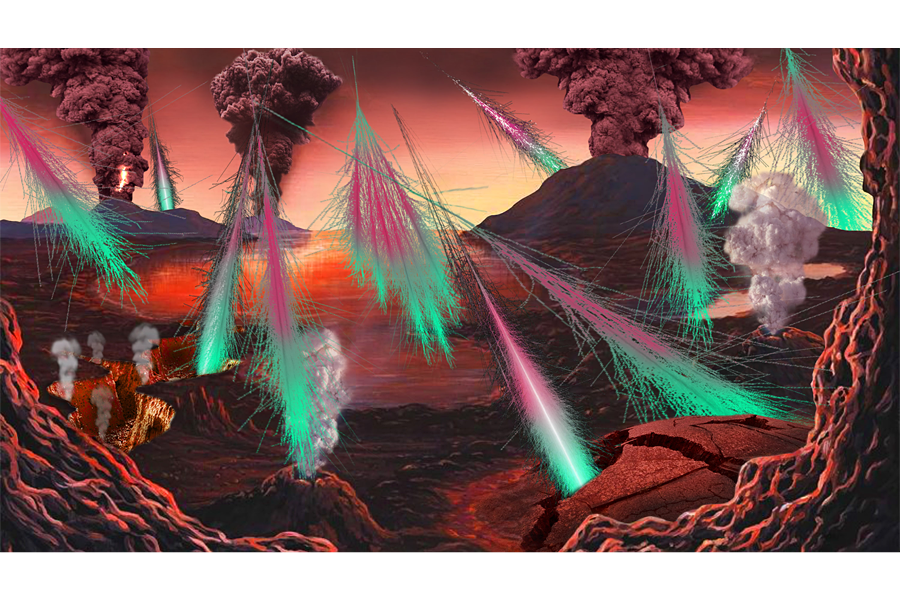Did intense solar flares prime our planet for life?
Loading...
A tantrum-throwing baby sun might have triggered the chemical reactions that made life on Earth possible, according to a new model proposed by NASA scientists.
For life as we know it to emerge, the planet needed to be warm and wet. Those conditions are evident as the sun beats down on Earth today, but 4 billion years ago the sun was not as strong. In fact, this young sun was so faint – at about 70 percent of today's brightness – that early Earth should have been more of a snowball than a tropical paradise.
And yet, some 3.8 billion years ago, life arose.
How was it that early Earth had liquid water and was warm enough for life to emerge, but the sun was not nearly the heat source it is today? Scientists call this the "faint young sun paradox."
The volatility of the young sun may actually resolve this problem, according to a new paper published Monday in the journal Nature Geoscience. And this process could inform scientists in the hunt for life on other planets, too.
The young sun wasn't just bombarding the early Earth with heat waves. The model is a bit more complex, as lead author Vladimir Airapetian explains, using human infants as a metaphor:
"Since birth, stars, like babies, undergo evolutionary emotional changes," Dr. Airapetian, a researcher at NASA's Goddard Space Flight Center, tells The Christian Science Monitor.
Human babies, Airapetian describes, are very emotional at first. They scream, they cry, they throw tantrums. Throughout all of these outbursts, they expel energy. Baby stars are similarly restless. They frequently spew out massive clouds of solar plasma in what's called a coronal mass ejection.
"Eventually they slow down in their emotions," Airapetian says. "So today our sun is a pretty emotionally stable star."
But 4 billion years ago, these bursts of plasma would have been frequent, perhaps daily. And those charged particles streamed away from the young sun and toward the young Earth.
As that solar plasma bombarded the early Earth, the magnetosphere, which forms a sort of protective bubble around our planet against solar wind, was compressed. This distorted magnetosphere would have allowed the charged particles to seep deep into the atmosphere.
Scientists suspect that the atmosphere was largely composed of nitrogen molecules, N2 , much as it is today. These charged particles would have forced both nitrogen and other molecules to split apart into free atoms. Then, these atoms would have bonded in new combinations.
One of the results of these chemical reactions would have been nitrous oxide, commonly known as laughing gas. Nitrous oxide, N2 O, is a very powerful greenhouse gas, 300 times as potent as carbon dioxide.
This abundance of nitrous oxide would have blanketed the Earth and trapped heat, making it so that the surface of our planet was warm enough to support liquid water and the development of life.
But water and warmth are not all the ingredients for life created by this process.
Other free atoms could bond together to form hydrogen cyanide, HCN, which, although poisonous, is thought to be a precursor to amino acids and nucleic acids, building blocks of life. And that HCN that arose low enough in the atmosphere would have become trapped in raindrops and fallen into bodies of water on the Earth, where it could have given rise to those building blocks.
This model may nicely set up prebiotic conditions on early Earth, but James Kasting, a geoscientist at Pennsylvania State University who was not part of the study, says "I don't think their mechanism could work even under the most favorable assumptions."
The problem, according to Dr. Kasting, lies in how much N2 O would be necessary to produce a sufficient warming effect.
Some of the N2 O molecules would be dissociated into atoms again thanks to ultraviolet radiation. And although Airapetian says the model takes into account the net production of N2 O, Kasting says that not enough would be produced in the lowest parts of the atmosphere to create sufficient warming.
The model has a maximum N2 O concentration between about 25 and 37 miles above the Earth's surface, Kasting points out. But they would have a much more significant effect at a height of around 6 miles or less. As such, he says, the model needs some sort of downward transport mechanism to carry more N2 O molecules closer to the surface of the Earth in order to work.
Debate over the faint young sun paradox is not new, Kasting says in a phone interview with the Monitor. "The faint young sun problem has been solved many times," he says. "But I'm sure it will be resolved many more times in the future."
"We argue about what the details of the solution are," he explains. "There are plausible solutions for the faint young sun problem, but it's very difficult to prove that any one of them is actually correct."
Another popular explanation was that early Earth's atmosphere was twice as thick as it is today, providing a warm blanket over the Earth. But recent fossilized air bubbles suggest that the opposite was true. In fact, the air pressure may have been less than half what it is today, according to a study published earlier this month.
So why debate over details of prebiotic conditions?
It's all about knowing what to look for in the hunt for extraterrestrial life. Airapetian says that it might be most fruitful to look for the beginnings of life on another planet. And understanding the specific conditions that yielded life on our own planet could help narrow the search.
"My ultimate goal is to find a planet like Earth in the process of making life," Airapetian says. "I call it pregnant Earth 2.0."








